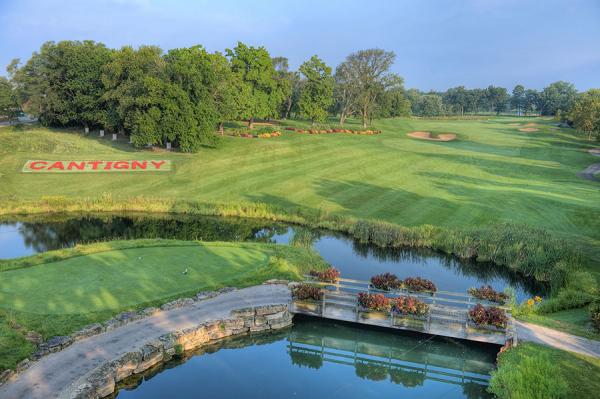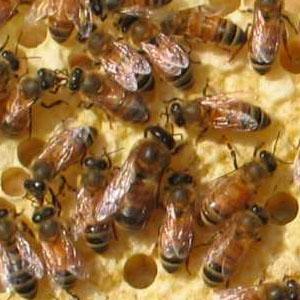
For much of the past three decades, Scott Witte, CGCS, has worked diligently to convince people that golf courses are diverse ecosystems that offer more to their respective communities than simply an outlet for physical recreation. Golf courses, Witte says, also can provide wildlife habitat as well as diverse native plants that attract beneficial insects. It is a message he has taken to golfers and nongolfers alike since he became superintendent at Cantigny Golf near Chicago in 1995. For the past six years, Witte has leaned on an unlikely prop to help him make his case even further.
Recently, Witte teamed with Bayer Environmental Science to host a Feed A Bee educational event at Cantigny in suburban Wheaton. The two-day event, which included an educational tour of Cantigny's bee-friendly grounds and the many pollinator-specific programs under way there like Witte's Bee Barometer project, largely targeted media from outside the golf industry in what he called a blogger-engagement event.
 The event attracted about a dozen representatives from various media outlets representing a variety of industries, including agriculture, golf and food production. It also presented Witte with an opportunity to share the work he has conducted the past six years on behalf of promoting healthy bee populations as well as his eco-friendly golf course-management programs.
The event attracted about a dozen representatives from various media outlets representing a variety of industries, including agriculture, golf and food production. It also presented Witte with an opportunity to share the work he has conducted the past six years on behalf of promoting healthy bee populations as well as his eco-friendly golf course-management programs."I wanted to open bloggers' minds about the beauty of golf's environmental opportunities," Witte said.
"The more people understand the logic of what is going on with bee populations and the importance of pollinators, the more they are an educated sounding board connected with good news about bees, not just the doom and gloom."
Tour stops included places like Honeybee Hill, where Witte maintains his beekeeping operation, native prairie gardens, the site of a future monarch feeding station and the Cantigny Golf Academy, where Witte has planted native grasses and pollinator-friendly plants. It also included a stop in a wooded area where native bee colonies have taken up residences in hollowed trees.
"I wanted to demonstrate how golf and bees can survive and thrive in harmony," Witte said.
"Education is important so the public doesn't see bees coming from a tree and think
'We have to kill these things.' "
The event also included a golf tournament that was rained out. Still, no one who registered wanted a refund of their $200 green fee since proceeds benefitted the Children's Discovery Museum in Normal, Illinois. Between green fees ($200 for each of 24 players) and corporate donations from the Robert R. McCormick Foundation, Kemper Sports and Bayer, Witte's event raised more than $12,000 for the museum.
For years, bees, like golf, have been under attack from multiple fronts. Weather patterns, parasites, disease, pesticides and loss of habitat have resulted in declining numbers of bees and a phenomenon known as colony collapse disorder, which was first documented in 2006, according to the U.S. Department of Agriculture. Thanks to the efforts of Witte and others, bees are on the rebound.
His Bee Barometer project helps promote and sustain healthy bee populations, which, he says provide a snapshot of the overall health and diversity of the surrounding environment he works so hard to provide at Cantigny, which is part of the 500-acre Cantigny Park.
"I love preaching the gospel of a healthy golf environment and diverse ecosystems on golf courses as awesome wildlife habitat," Witte said. "If we don't have an avenue to communicate with people, we'll never convince them of what we are doing for the environment."
The bee population, according to the U.S. Department of Agriculture dropped steadily from 1989 to 2008. For the past eight years, however, those numbers have been on the rise. There were 2.7 million honeybee colonies in 2014 (the most recent data available), which is a 20-year high, according to the USDA.
"The numbers for bees are relatively stable, and we have the data to back that up," Witte said. "Bees still face many stresses, and we're not out of the woods yet. There is more we can do, especially in golf, to provide forage and protect pollinators.
"Nobody loves a tragedy more than the media, and as easy as it would be to latch onto the sky-is-falling report, there needs to be more people involved in the good news of what is going on with pollinators and honey bees."
Witte has been promoting the environmental efforts of golf course superintendents for years.
Every year, he fashions rain barrels from recycled fertilizer drums and sells them to raise money to fund the Bee Barometer project and participates in a gardening event sponsored by a recycling awareness organization known as SCARCE (School & Community Assistance for Recycling and Composting Education). All along the way, he tells his story to anyone and everyone who will listen.
"I win those people over one at a time," he said. "Sometimes, I get people who look at me cross-eyed, because they are convinced golf can do no good in nature. You have to start a dialog with that segment and show them physically what you are doing.
"That is the goal of the Bee Barometer project and the Feed a Bee program. That is the message we want to get out, that golf is part of the solution, not part of the problem."

